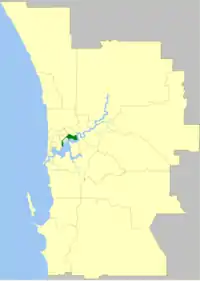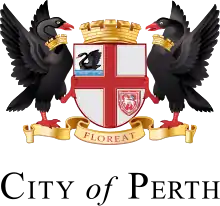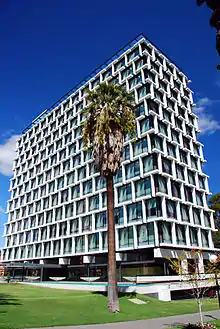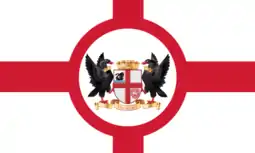City of Perth
The City of Perth is a local government area and body, within the Perth metropolitan area, which is the capital of Western Australia. The local government is commonly known as Perth City Council. The City covers the Perth city centre and surrounding suburbs. The City covers an area of 20.01 square kilometres (8 sq mi) and had an estimated population of 21,092 as at 30 June 2015. On 1 July 2016 the City expanded, absorbing 1,247 residents from the City of Subiaco.
| City of Perth Western Australia | |||||||||||||||
|---|---|---|---|---|---|---|---|---|---|---|---|---|---|---|---|
 | |||||||||||||||
| Population |
| ||||||||||||||
| • Density | 1,089.31/km2 (2,821.3/sq mi) | ||||||||||||||
| Established | 1856 | ||||||||||||||
| Area | 20.01 km2 (7.7 sq mi)[3] | ||||||||||||||
| Lord Mayor | Basil Zempilas | ||||||||||||||
| Council seat | Council House, Perth | ||||||||||||||
| Region | Central Perth | ||||||||||||||
| State electorate(s) | Perth | ||||||||||||||
| Federal Division(s) | Perth | ||||||||||||||
 | |||||||||||||||
| Website | City of Perth | ||||||||||||||
| |||||||||||||||
History
.jpg.webp)

In 1829, Captain James Stirling founded Perth as part of the Swan River Colony. A Perth Town Trust was formed in 1832, but remained largely non-functional for many years due to lack of finance and administrative capacity leading to its dissolution in 1858.[4] The City of Perth was officially declared on 23 September 1856.[5] In 1871, the City of Perth was reconsituted as a Municipal Corporation.
In 1915, following the efforts of WE Bold and the greater Perth movement, the City absorbed the Municipality of North Perth (1901) and the Municipality of Leederville (1895), and on 1 November 1917, the Municipality of Victoria Park was also absorbed. A year later, it absorbed territory from Perth Road Board (including the Belmont Park Racecourse) and purchased the 526 hectares (1,300 acres) Limekilns Estate in the western suburbs. The City developed the suburbs of Floreat Park, Wembley Park and City Beach on these lands.
In 1925, a new City of Perth Act gave the City additional powers over building control and regulation, including the power to declare new streets. In 1930 the first town planning committee was established.
Criticism of the City’s governance led to a Royal Commission in 1938 on the grounds that the development of the western suburbs had led to the neglect of health and building administration in the central city area.
By 1962, the council had 27 members representing nine wards.[6] In 1963 the Metropolitan Region Town Planning Scheme Act required the City to establish a town planning department—which they did by appointing architect Paul Ritter in 1965.[7] Ritter’s two year tenure was short and turbulent, leading to public conflict with councillors and his termination in 1967.
The City’s first town planning scheme was submitted to the Town Planning Board in 1973, but not formally adopted until 1985. The reason for the delay was a state government desire to take discretionary powers out of the hands of the Council. Council was felt to be too easily influenced by powerful developers.[8]
On 1 July 1994, following the passage of the City of Perth Restructuring Act (1993), the City of Perth was broken up and a significantly reduced City of Perth constituted. The Town of Victoria Park, Town of Cambridge and Town of Vincent were created from the former boundaries of the City.[9] The first elections were held on 6 May 1995, with eight councillors and a mayor.
The City of Perth Act 2016 defined Perth as the capital of Western Australia,[10] and expanded the City's boundaries to include a number of landmarks including Kings Park, University of Western Australia, Perth Children's Hospital and the Queen Elizabeth II Medical Centre. The boundary changes took effect on 1 July 2016.[11] Approximately 1,247 residents from Nedlands and Subiaco in the City of Subiaco were transferred to the City of Perth, and the City expanded to a total area of 20.01 square kilometres (8 sq mi).[3]
The Perth City Council was suspended on 2 March 2018, pending the establishment of a public inquiry into the council, by Local Government Minister David Templeman. The council was administered by three Commissioners until 18 October 2020.[12]
Council
Suburbs
* The parts of these suburbs north of Newcastle and Summers Streets fall within the City of Vincent. These localities are only partially contained within the City of Perth boundary.
** The parts of these localities were transferred from the City of Subiaco in 2016. These localities are only partially contained within the City of Perth boundary.
Population
Pre-1915 composition
| Year | Population |
|---|---|
| 1911 | 35,767 |
1915-1994 composition
|
|
The 1991 population has been broken down by the Australian Bureau of Statistics as follows: Perth (C) 7,604; Cambridge (T) 22,740; Victoria Park (T) 24,313; Vincent (T) 24,765.[13]
1994-present composition
|
|
Twin towns and sister cities
The City of Perth is twinned with:
|
Flag and coat of arms
 | |
| Use | City |
|---|---|
| Proportion | 1:2 |
| Adopted | 1975 |
The official Flag of Perth represents the city of Perth, Western Australia. It features the Saint George's Cross overlaid with the coat of arms of Perth in the centre. Though the designer of the flag is unknown, it is thought to have been designed prior to 1872. In the 1920s, the black swan was removed from the top left quadrant of the flag and replaced with the coat of arms in the centre of the cross.[15][16][17]
The coat of arms were originally granted to the City of Perth on 2 December 1926. They were altered with the addition of part of the arms of Perth, Scotland in 1949.
Heritage listed places
As of 2020, 1,018 places are heritage-listed in the City of Perth,[18] of which 219 are on the State Register of Heritage Places.[19]
References
- Australian Bureau of Statistics (27 June 2017). "Perth (C)". 2016 Census QuickStats. Retrieved 23 November 2017.

- "3218.0 – Regional Population Growth, Australia, 2017-18". Australian Bureau of Statistics. 27 March 2019. Retrieved 3 December 2019. Estimated resident population (ERP) at 30 June 2018.
- "FAQs for Transitioning Residents". City of Perth. Retrieved 25 April 2016.
- Johns, J. R. H. (1949). "The Development of Local Government in Western Australia". The Australian Journal of Public Administration: 172–179.
- "The Inquirer and Commercial News (Perth, WA: 1855-1901) Wednesday, 24th September, 1856, page 2".
- WA Electoral Commission, Municipality Boundary Amendments Register (release 2.0), 31 May 2003.
- PCC (Perth City Council), Minutes, 15/06/1964, p. 193.
- Gregory, Jenny (26 February 2009). "Development pressures and heritage in the Perth Central Business district 1950-90". Australian Economic History Review. 49 (1) – via Wiley Online Library.
- "City of Perth Restructuring Act 1993". Act of 20 December 1993. Retrieved 8 April 2016.
- "City of Perth Act 2016". Act of 3 March 2016. Retrieved 8 April 2016.
- Foster, Brendan (26 February 2016). "City of Perth Act could cost jobs and impact services in Subiaco: Mayor". WAtoday.com.au. Retrieved 8 April 2016.
- Hon David Templeman MP (2 March 2018). "City of Perth council suspended, inquiry panel to determine fate" (Media Release). Western Australian Government. Retrieved 9 May 2018.
- Time series data accompanying 2001 Census at http://www.abs.gov.au. Accessed 10 December 2009.
- 姉妹・友好・兄弟都市 [Twin cities]. Kagoshima International Affairs Division (in Japanese). Archived from the original on 2 June 2013. Retrieved 8 August 2013.
- "History of the Council". City of Perth. Retrieved 19 December 2013.
- http://www.crwflags.com/fotw/flags/au-wa-pe.html
- http://www.brisbanetimes.com.au/queensland/the-city-standard-but-do-you-recognise-it-20120404-1wcu8.html
- "City of Perth Park Heritage Places". inherit.stateheritage.wa.gov.au. Heritage Council of Western Australia. Retrieved 15 April 2020.
- "City of Perth State Register of Heritage Places". inherit.stateheritage.wa.gov.au. Heritage Council of Western Australia. Retrieved 15 April 2020.